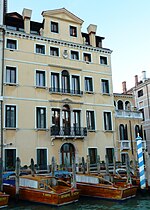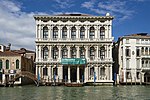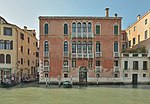Palazzo Balbi, Venice
1582 establishments in ItalyBuildings and structures completed in 1582Palaces in Sestiere DorsoduroPalaces on the Grand Canal (Venice)Renaissance architecture in Venice

Palazzo Balbi is a palace on the Canal Grande, Venice, northern Italy. It is included in the sestiere (quarter) of Dorsoduro, to the right of Ca' Foscari. Currently it is the seat of the President of the Veneto region and of the regional council.It was built from 1582, under design by Alessandro Vittoria as the residence of the Venetian patrician family of the Balbi. In the 19th century it was acquired by Michelangelo Guggenheim and later by the Adriatic Electric Society. It became a property of the Veneto region in 1971.
Excerpt from the Wikipedia article Palazzo Balbi, Venice (License: CC BY-SA 3.0, Authors, Images).Palazzo Balbi, Venice
Calle Venier, Mestre Venezia-Murano-Burano
Geographical coordinates (GPS) Address External links Nearby Places Show on map
Geographical coordinates (GPS)
| Latitude | Longitude |
|---|---|
| N 45.435022 ° | E 12.327051 ° |
Address
Palazzo Balbi
Calle Venier
30170 Mestre, Venezia-Murano-Burano
Veneto, Italy
Open on Google Maps











